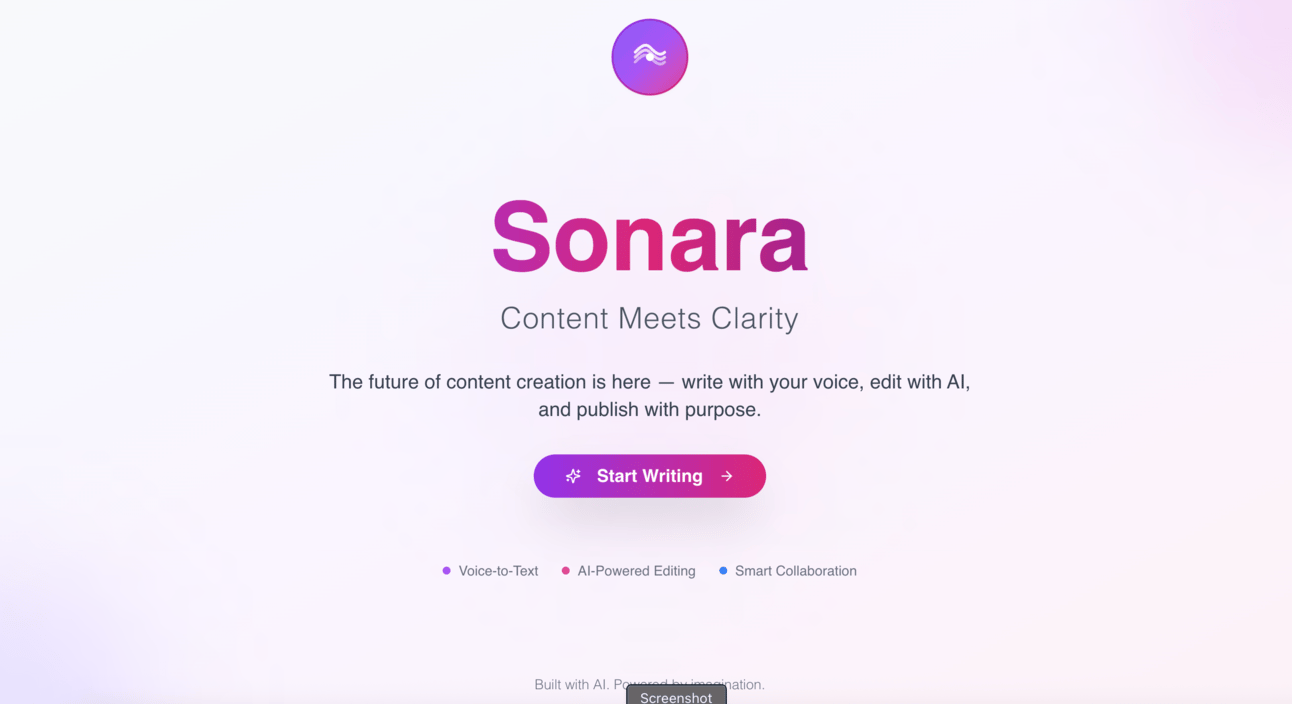- The Atomic Builder
- Posts
- The Most Powerful AI Feature Isn’t the Model - It’s the Canvas
The Most Powerful AI Feature Isn’t the Model - It’s the Canvas
Rethinking How We Write with AI - The Interface Is the Innovation

Hi, and welcome to The Atomic Builder!
This week, I took a shot at reimagining how we write.
Not just how we generate content - but how we think, structure, and collaborate with AI in the process.
The result is Sonara - a prototype for what I’m calling Content Authoring 2.0.

Sonara - voice input is the future
But let’s be real: this isn’t the final form. It’s a stepping stone, representing what we should expect these tools to do…now.
Because we all know what’s coming next: agents.
Got this from a friend? Join other product managers, founders, and creators staying ahead of AI-powered product building. Subscribe to get The Atomic Builder every week.
The Interface Is the Innovation, right?
The blank page is a lie.
We still treat writing like it's ink on paper - a single blinking cursor, static output, linear flow. But when we introduce AI, when we collaborate with systems that can synthesize, summarize, rewrite, and reframe - the medium needs to change.
What we’ve seen over the last 12 months or so, is that it isn’t just content that should evolve.
It’s the interface itself. Or at least it should.
What's Broken With Today's Tools
I see three key issues with the landscape today:
Word processors are passive containers, nobody uses.
Chat interfaces are shallow - you can’t build in them. We can barely extract value from long, out of control chats. Don’t get me started on ‘canvas’ in ChatGPT.
Static docs = frozen thought.
These tools weren’t made for real-time agents, live data, or spoken ideas. They were made for solo thinkers with keyboards and deadlines. That world is gone.
Exploring a New Direction: Sonara
So I built a prototype.
Sonara is an early experiment in what content authoring could become - a voice-enabled, AI-assisted canvas where ideas are crafted in modular blocks, but crucially AI works as a co-writer, and the interface helps you think, not just type.
The demo/promo I created is available to view on a LinkedIn post I shared:
Key Interactions That Reimagine Authoring
So, how does it change the experience today? Think about the experience as a co-pilot on steroids. In the right place, at the right time. Some of the key enhancements I envision in this experience:
🎙️ Speak First
Talk your ideas out loud. Sonara transcribes, cleans up, and lets you think like a storyteller - not a typist.
🔍 “Challenge This Block”
Click one button and get critical feedback: weak assumptions, vague phrasing, logical gaps.
🧠 Agent Trails
Don’t just get output. Understand how it was generated - prompts, reasoning steps, and alternatives.
🎯 Smart Completion Nudges
Pause mid-sentence? Sonara gently suggests finishing it stronger, adding a stat, or softening the tone.
🧭 Perspective Transformer
Switch the lens: turn a block into a contrarian take, a board-facing summary, or a risk-mitigated version.
The future? Your writing moves away from being a static doc. It’s a living object - one you can inspect, challenge, and evolve in real-time.
How It Compares - and Why It’s Just the Beginning
There are some amazing tools out there today like Grammarly, which helps writers refine tone and grammar with impressive precision, and Lex.page, which offers fast AI powered drafting inside a minimalist, clean editor.
But Sonara is exploring a different angle: not just improving writing, but transforming the entire act of authoring. It's about modular thinking, visible reasoning, and AI as a transparent collaborator - not just a button.
This is not a replacement for existing tools - it’s a prototype to explore what’s next.
I don’t think its the end state, far from it. The Sonara concept feels like more of an interim measure, ahead of fully agentic workflows embedded into the process of writing.
Final Thoughts
We don’t need better prompts. We need better environments to think in.
The tools we use to write, shape how we think.
If AI is becoming part of our thinking, our interfaces need to reflect that - not fight it.
Sonara is one vision of what that could look like.
But there’s a deeper shift underway - one that goes beyond interfaces and into how work itself is delegated, coordinated, and executed:
Coming Soon, I’ll explore agentic workflows - and why product teams should start preparing now for a future where users don’t just write… they orchestrate.
Until next time, keep experimenting, keep building, and as always - stay atomic. 👊
Faisal
This Week’s Build Beats 🎵
Each issue, we pair the newsletter with a track to keep you inspired while you build.
This week, given we’re reflecting on a shift to voice-enabled interfaces, what better track to pair to than the ambient brilliance of Marconi Union.
🎧 “Weightless” – Marconi Union
Grab the playlist on Spotify - I add to it each week!
 | Thanks for Joining! I’m excited to help usher in this new wave of AI-empowered product builders. If you have any questions or want to share your own AI-building experiences (the successes and the failures), feel free to reply to this email or connect with me on socials. Until next time… Faisal |
P.S. Know someone who could benefit from AI-powered product building? Forward them this newsletter!
